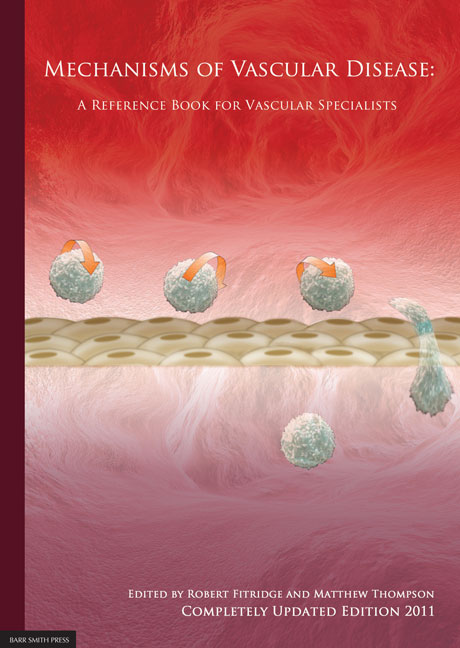Book contents
- Frontmatter
- Contents
- List of Contributors
- Detailed Contents
- Acknowledgements
- Abbreviation List
- 1 Endothelium
- 2 Vascular smooth muscle structure and function
- 3 Atherosclerosis
- 4 Mechanisms of plaque rupture
- 5 Current and emerging therapies in atheroprotection
- 6 Molecular approaches to revascularisation in peripheral vascular disease
- 7 Biology of restenosis and targets for intervention
- 8 Vascular arterial haemodynamics
- 9 Physiological Haemostasis
- 10 Hypercoagulable States
- 11 Platelets in the pathogenesis of vascular disease and their role as a therapeutic target
- 12 Pathogenesis of aortic aneurysms
- 13 Pharmacological treatment of aneurysms
- 14 Pathophysiology of Aortic dissection and connective tissue disorders
- 15 Biomarkers in vascular disease
- 16 Pathophysiology and principles of management of vasculitis and Raynaud's phenomenon
- 17 SIRS, sepsis and multiorgan failure
- 18 Pathophysiology of reperfusion injury
- 19 Compartment syndromes
- 20 Pathophysiology of pain
- 21 Post-amputation pain
- 22 Treatment of neuropathic pain
- 23 Principles of wound healing
- 24 Pathophysiology and principles of varicose veins
- 25 Chronic venous insufficiency and leg ulceration: Principles and vascular biology
- 26 Pathophysiology and principles of management of the diabetic foot
- 27 Lymphoedema – Principles, genetics and pathophysiology
- 28 Graft materials past and future
- 29 Pathophysiology of vascular graft infections
- Index
14 - Pathophysiology of Aortic dissection and connective tissue disorders
Published online by Cambridge University Press: 05 June 2012
- Frontmatter
- Contents
- List of Contributors
- Detailed Contents
- Acknowledgements
- Abbreviation List
- 1 Endothelium
- 2 Vascular smooth muscle structure and function
- 3 Atherosclerosis
- 4 Mechanisms of plaque rupture
- 5 Current and emerging therapies in atheroprotection
- 6 Molecular approaches to revascularisation in peripheral vascular disease
- 7 Biology of restenosis and targets for intervention
- 8 Vascular arterial haemodynamics
- 9 Physiological Haemostasis
- 10 Hypercoagulable States
- 11 Platelets in the pathogenesis of vascular disease and their role as a therapeutic target
- 12 Pathogenesis of aortic aneurysms
- 13 Pharmacological treatment of aneurysms
- 14 Pathophysiology of Aortic dissection and connective tissue disorders
- 15 Biomarkers in vascular disease
- 16 Pathophysiology and principles of management of vasculitis and Raynaud's phenomenon
- 17 SIRS, sepsis and multiorgan failure
- 18 Pathophysiology of reperfusion injury
- 19 Compartment syndromes
- 20 Pathophysiology of pain
- 21 Post-amputation pain
- 22 Treatment of neuropathic pain
- 23 Principles of wound healing
- 24 Pathophysiology and principles of varicose veins
- 25 Chronic venous insufficiency and leg ulceration: Principles and vascular biology
- 26 Pathophysiology and principles of management of the diabetic foot
- 27 Lymphoedema – Principles, genetics and pathophysiology
- 28 Graft materials past and future
- 29 Pathophysiology of vascular graft infections
- Index
Summary
INTRODUCTION
Thoracic aortic dissection (TAD) is the most common aortic catastrophe, occurring in approximately 5 to 30 cases per 1 million Persons per year. It carries a significant morbidity and mortality risk, with 21% of patients dying prior to hospital admission. Recent improvements in the understanding of both the molecular biology and genetics of vascular disease has led to greater clarity of the pathogenesis of acute TAD and a number of associated diseases of the thoracic aorta. Since the initiation of the International Registry of Aortic Dissection (IRAD) in 1996 there has been an evolution of terminology in relation to TAD, and the more encompassing term acute aortic syndrome (AAS) is now utilised to include TAD and a number of other pathologies including intramural haematoma (IMH) and penetrating aortic ulcer (PAU).
In broad terms this classification reflects recent advances in understanding in relation to the pathology and natural history of TAD, and the recognition that TAD is part of a spectrum of thoracic aortic pathology. These individual processes will be discussed separately along with some of the underlying pathologic phenomena that lead to AAS/TAD.
Embryology of thoracic aorta and arch vessels
The formation of blood vessels occurs between the third and eighth week of embryological development. The ventral aortas fuse into the endocardial tube and circulate blood by the end of the third week. During this process a series of mesenchymal clefts lined by what will become endothelium fuse and form two pairs of longitudinal channels – one medial and one lateral.
- Type
- Chapter
- Information
- Mechanisms of Vascular DiseaseA Reference Book for Vascular Specialists, pp. 255 - 276Publisher: The University of Adelaide PressPrint publication year: 2011
- 3
- Cited by



